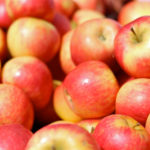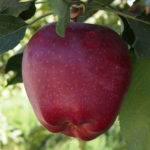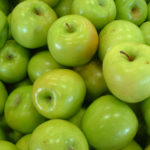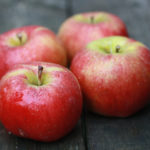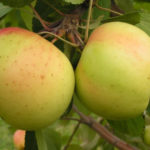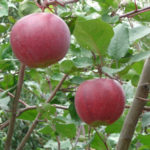Fuji apple variety
Apples are a very hot commodity, especially winter varieties, which have a long shelf life and constitute the main assortment of supermarkets. Among the varieties that are leading in the world in cultivation and sales, the lion's share is occupied by American apple trees. And they are popular not only because of their excellent characteristics and marketability, but rather due to competent advertising, which, as you know, is the engine of commerce. But among the ten most popular apple trees in the world, the third place, due to its firm crunchy pulp and sweet taste, is occupied by the Japanese variety, the name of which is on everyone's lips - Fuji. Unfortunately, the Japanese fruit is not included in the State Register of Breeding Achievements of Russia, although some of its varieties, for example, Fujik or Fujina, are included in it.
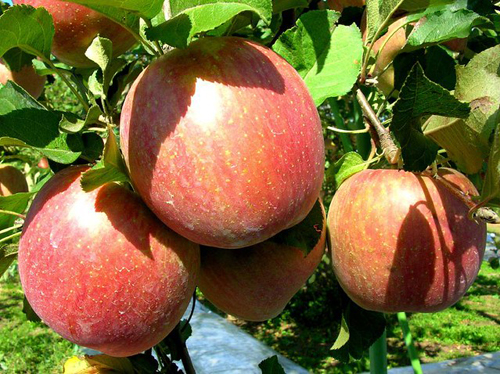
History of creation and name
The Fuji apple tree is a real long-liver. Work on its creation began in Japan in the 20s of the last century. The new variety appeared at the Tohoku research station in Morioka in 1939. But the novelty became available for cultivation only in 1962. Not native varieties were used as parental forms. The mother plant was a famous one that needs no introduction Red Delicious, paternal - Rolls Janet. Both are achievements of American breeding. There are 2 versions of the name. According to the first, the new apple tree got its name in honor of the Fujisaki village, next to which the Tohoku station is located. Other sources suggest that the name of the apple tree was given in honor of Mount Fuji (Fuji), sacred to the Japanese.
Growing regions
The place where Fuji was created is characterized by a relatively mild climate, in winter the temperature is mainly kept within the range of -5 ° C or -8 ° C. But the breeders set themselves the task of developing a variety that is resistant to lower temperatures. And judging by the fact that the popularity of culture is constantly growing outside their homeland, the scientists coped with the task perfectly. Having crossed the border of Japan, the culture confidently entered the territory of China and Korea, where it became quite popular in a short time. In the United States, the variety became a commercial sensation in 1980 and has since been grown in the traditional apple states: New York, Washington, California, Michigan. Our hero feels very comfortable in sunny Australia, India and Brazil, European countries with a warm climate - Italy, Greece, Spain, southern France. In Russia, the leader of consumer sympathies is not very common due to the harsher climate in most of the country. The overwhelming majority of Fuji apples lying on our counters are supplied by China. But, according to sources, this variety is successfully grown in the Krasnodar Territory, in the Stavropol Territory. Not so fast, but it is mastering the middle zone of Russia. Also, the climate of the southern regions of Ukraine, Moldova, Belarus is suitable for the apple tree. For regions with short summers, the variety is not suitable due to the fact that for the normal development and ripening of fruits, it needs at least 3200 hours of sunshine per year.
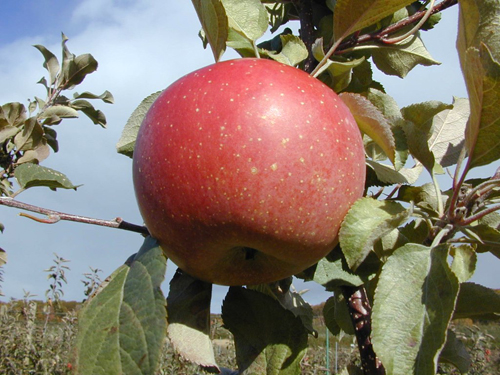
Description
The plant grows rather quickly at a young age, then the growth ability decreases. The average growth of a tree is about 4 - 6 meters, but the stock has a great influence on its performance. The crown is dense, without formative pruning, it looks shaggy, but well-groomed and properly formed looks neat and has an oval or rounded-oval shape. On a stunted rootstock crown, they are often spindle-shaped. The annual growth is approximately 0.6 meters in height and the same in width. The bark of skeletal branches and trunk is light brown with a gray tint, not too wrinkled. The main branches of the apple tree extend from the trunk almost at right angles, which provides a fairly strong connection of the wood. Young shoots are upright, smooth, the bark on them has a brighter color.Lentils are small, grayish, poorly visible, in large numbers. The internodes are medium. The tree is quite leafy. The leaves of the culture are ordinary, dark green, oval or lanceolate-oval in shape, the tip is slightly elongated, the base is rounded-wedge-shaped, the edges are serrate, broad-wavy. The leaf blade is medium-wrinkled, slightly shiny, not pubescent. Petioles are ordinary, located at an angle close to a straight line to the shoot. Stipules are elongated-oval, small. The flowers are saucer-shaped, white, of medium size.
Fuji fruits are medium to large in size, weighing from 140 to 250 grams, sometimes more. The shape is rounded, often slightly elongated, the surface is smooth. The funnel is deep, of medium width. A saucer of medium depth and width. The cup is half-open. The seed chambers are small, oblong, closed or open into the axial cavity. The peduncle is long, not thick. The skin is not thick, but dense, dry to the touch, little or no shine. The color of the apple cannot be called very bright, but, nevertheless, it looks quite attractive and resembles Red Delicious. The main color is yellow-green, the integumentary color covers almost the entire surface and is presented in the form of a blurred dull pink or red-pink striped pattern. The subcutaneous points are light, well visible. The pulp is of a pleasant light cream shade, sometimes white, quite dense, crispy, very juicy. The aroma is quite pleasant, floral-honey, the longer the fruit lays, the richer it becomes. The taste is excellent, sweet, 100 grams of pulp contains 9-11% sugar. True, when ripe in cool regions, a subtle sourness may be present. Assessment of tasters is not less than 4.8 points. According to the characteristics of the pulp, the variety is similar to the Rolls Janet apple tree.
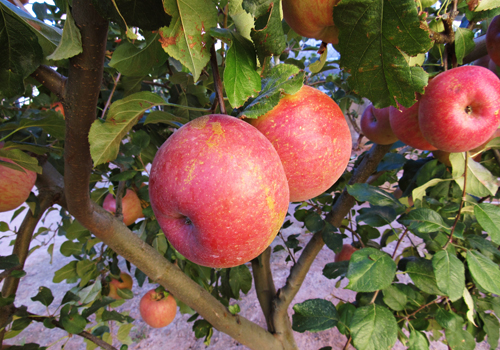
Features of the
- Apples can be eaten straight from the tree. The later the fruits are removed, the more sweetness they gain. Even in the process of lying, the pulp does not become loose or sandy, it does not lose its density, it remains the same crunchy and juicy;
- perhaps, in the first 2 years of fruiting, the taste will not correspond to the declared ones, but starting from the third year it will be possible to appreciate the real and unique taste of the fruits of our hero;
- apples are prone to damage by glassiness, but this does not affect the taste and marketability. On the contrary, vitreousness is not considered a defect in many countries. In China and the USA, the vitreousness of the core of the Fuji apple is considered an integral sign of the quality of the fruit. In Japan, fruits with radial vitreousness are called "honey apples" and are classified as "Premium" class, raising their price. The price of such fruits is doubled in Spain.
Characteristics
- The fruiting period of the variety directly depends on the stock. A dwarf rootstock will allow you to get a harvest from an apple tree already in the 2nd year after planting. On a medium-sized plant, the first apples will appear in 3-4 years. On a seedling rootstock, the wait will drag on for 5 - 6 years. But it is the seedling stock that is able to give the tree the longest period of productive life, up to 30 - 40 years, with a total duration of more than 50 years. On a dwarf rootstock, the productive period will be 20 - 25 years;
- in terms of ripening, the variety is late. In the southern regions, the harvest period can start in early or mid October and ends in November. In regions with a cooler climate, for example, in a forest-steppe, apples ripen by the end of October, almost 20 days later than Red Delicious;
- the crop does not ripen at the same time, therefore, several harvests are carried out, first of all, removing those fruits that have reached the required degree of staining;
- apple blossoms occur at a later date - at the end of May, therefore, as a rule, even in regions with a temperate climate, return cold snaps are not a threat to flowers. Flowering lasts from a week to 12 days, depending on the weather;
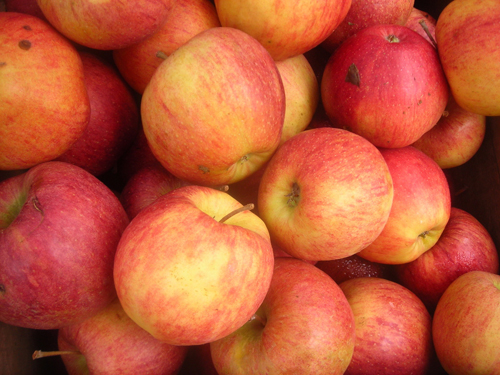
- the productivity of our heroine is not bad. On average, a 10-year-old tree is capable of yielding from 14.0 to 21.0 t / ha. Interesting results were revealed in the course of experiments on the method of forming and guiding the central conductor.So, during two years of observations, it was possible to reveal that during the formation of a crown of the slender spindle type with shortening of the central conductor, it was possible to remove 90.5 centners from one hectare. But with the same method of formation, but without shortening the conductor, the yield is higher - 98.8 c / ha;
- shedding was not observed for the variety. The fruits are firmly attached to the branches and can easily hold out until the onset of the first frost;
- with proper care and rationing, the variety shows stable annual fruiting. But if you neglect this procedure, then there may be a periodicity in the fruiting of the apple tree. If in private homestead gardens, manual rationing is carried out, then in industrial plantings they use chemical thinning, that is, they use special preparations. For our hero, ethephone and ammonium thiosulfate are recommended;
- Fuji is quite a heat-loving culture. And although its frost resistance is not high enough, it is quite comparable with the average results. Many sources provide information that the plant is able to withstand temperature drops down to -25 ° C. To increase this characteristic, you should correctly select the stock, with the help of which our hero can withstand the lower temperatures of central Russia;
- the immunity is average. Without the necessary preventive treatments, the variety can be affected by scab, powdery mildew and fire blight;
- drought resistance of the apple tree is high;
- the transportability of the crop is at a high level;
- by keeping quality among the leaders and on a par with Golden Delicious. In an ordinary basement, apples will lie for 3 months, in special gas chambers - until the next harvest;
- method of consumption - primarily in natural form. But fruits are also suitable for processing. They make high-quality jam, jam, baking stuffing, fruit puree, juice, compote.
Pollinators
Good yields and high marketability of Fuji fruits, unfortunately, are not possible without a reliable pollinator. For a self-infertile variety, the most suitable neighbors will be: Idared, Golden Delicious, Red Delicious, Gala, Granny Smith, Ligol, Pinova, Rubin, Everest, Renet Simirenko.
Agrotechnics
Both autumn and spring are suitable for planting an apple tree. True, in the spring, leaving will be complicated by the need for more frequent watering. Choose an even, sunny plot, the more light, the higher the quality of the fruit. During the growing season, the site should be slightly blown to reduce the risk of fungal diseases, but at the same time, during the winter period, it should be protected from the prevailing winds. Any loose and nutritious soil with neutral acidity is suitable for the normal development of the tree. The groundwater level should not lie above 1.5 - 2.0 meters to the soil surface, since the apple tree does not tolerate stagnant water in the roots. Watering should be carried out infrequently, but abundantly, so that the soil in the root zone is moistened at least 50 cm deep. Top dressing is carried out according to the standard scheme, the alternation of mineral fertilizers and organic matter is allowed. Preventive treatments for fungal diseases are carried out at least 3 times. The formation of the crown should be started immediately after the spring planting or the next spring after the autumn procedure. Then, in order to reduce the density of the crown, thinning pruning is carried out every spring, sanitary - only as needed. MM 106 and M9 are suitable as a rootstock for our hero. But many still consider the M9 to be the most successful. On it, the crop load is much higher and there is no periodicity.
Fuji is an incredibly popular variety native to the land of the rising sun, where they know how to appreciate beauty. Japanese breeders were able to create a culture that conquered not only native spaces, but the whole world.Incredible palatability combined with high shelf life have made the variety one of the most farmed and marketed varieties. The main characteristics make it possible to cultivate an apple tree not only in private gardens, but also in industrial plantings. But there are nuances, on the implementation of which not only the yield in the current season depends, but further productivity. This is rationing, thanks to which it is possible to grow large-fruited crops and at the same time avoid overloading the tree.
The Fuji apple tree has proven to be productive not only in terms of yield. Breeders have created at least 40 clones of the popular variety. Each of them is beautiful in its own way. Someone tastes better than the main variety, someone ripens earlier, someone has a higher winter hardiness. The most popular are: Benny Shogun, Raku-Raku, Yataka, Toshiro, Fujik, Fuji Kiku 8, Fujion, Fuji Fubraks, September Wonder Fuji, Zen Aztec, Red Fuji.
